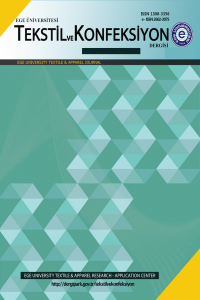WICKING & SORPTION ABILITY ON KNITTED FABRICS: EXPERIMENTAL AND THEORETICAL STUDIES
WICKING & SORPTION ABILITY ON KNITTED FABRICS: EXPERIMENTAL AND THEORETICAL STUDIES
Knitted fabric, capillary rise linear logarithmic model, water sorption kinetics, sorption ability,
___
- 1. CSE, (May 2006). Study on pollution of Bandi river by textile industries in pali town, Centre for Science and environment, New Delhi.
- 2. Stämpfli, R., Brühwiler, P. A., Rechsteiner, I., Meyer, V. R., et al. X-ray tomographic investigation of water distribution in textiles under compression – Possibilities for data presentation. Measurement. 2013, Vol. 46, Issue 03, pp. 1212-1219.
- 3. Youngmin, J., Chung, H. P., Tae, J.K. Effect of heat and moisture transfer properties on microclimate and subjective thermal comfort of caps. Textile research journal. 2010, Vol. 80, Issue 20, pp. 2195-2203.
- 4. Gat, A. D., Vahdani, A., Navaz, H., Nowakowski, A., Gharib, M. Asymmetric Wicking and Reduced Evaporation Time of Droplets. Penetrating a Thin Double-Layered Porous Material. Applied Physics Letters. 2013, Vol. 103, Issue 13.
- 5. Harnett, PR., MEHTA, PN. A survey and comparaison of laboratory test methods for measuring wicking. Textile research journal. 1984, Vol. 54, Issue 7, pp. 471-478.
- 6. Princen, H. M. J. Colloid Interf. Sci. 1968, Vol. 30.
- 7. Dullien F A L, El-Sayed M S, Batra V K, J. Colloid and interface sci., 1977, vol. 60.
- 8. Marmur A, J. Colloid and interface sci., 1988, vol. 124, Issue 1.
- 9. Wehner J, Miller B and Rebenfeld L. Text. Res. J., 1988, vol. 58, pp. 581-592.
- 10. Li Y and Luo Z, Text. Res. J., 1999, vol. 69, pp. 760-768
- 11. Bayramli, E., Powell, R. L. Colloid Surface. 1991, Vol. 56.
- 12. Deng, J. L., Zhu, Y. D., Wang, J. H., Meng, Z. H. J. Compos. Mater. 2003, Vol. 249.
- 13. Zhong, W., Xing, M. Q. J. Colloid Interf. Sci. 2004.
- 14. Lukas, D., Chaloupek, J., Kost’akova, E., Pan, N., Martinkova, I. Morphological transitions of capillary rise in a bundle of two and three solid parallel cylinders. Physica A: Statistical Mechanics and its Applications. 2006, Vol. 37, pp. 226-248.
- 15. Lukas, D., Chaloupek, J. Wetting between parallel fibres; column-unduloid and column disintegration transitions. Proc. Inst. Mech. Eng. H. 2003, Vol. 217, Issue 04, pp. 273-280.
- 16. Perwuelz, A., Mondon, P., Cazé, C. Experimental Study of Capillary Flow in Yarns. Textile Res. J. 2000, Vol. 70, Issue 04, pp. 333-339.
- 17. Perwuelz, A., Mondon, P., Cazé, C. Liquid organization during capillary rise in yarns – influence of yarn torsion. Polymer Testing. 2001, Vol. 20, pp. 553-561.
- 18. Hamdaoui, M., Fayala, F., Ben Nasrallah, S. Experimental Apparatus and mathematical model for determination of parameters of capillary rise in fabrics. Journal of Porous media. 2006, Vol. 9, Issue 04, pp. 381-392.
- 19. Hamdaoui, M., Fayala, F., Ben Nasrallah, S. J. Porous Media. 2007, Vol. 9.
- 20. Hamdaoui, M., Fayala, F., Ben Nasrallah, S. J of porous Media. 2008, vol. 11, Issue 3, pp. 231-240.
- 21. Hamdaoui, M., Fayala, F., Ben Nasrallah, S. AUTEX Research Journal. 2008, vol. 8, Issue 2, pp. 44-48.
- 22. Hamdaoui, M., Achour, N.S., Ben Nasrallah, S. The Influence of woven fabric structures on Kinetics of Water Sorption. Journal of Engineered Fibers and Fabrics. 2014, Vol. 9, Issue 1.
- 23. Achour, N.S., Baffoun, A., Hamdaoui, M., Ben Nasrallah, S. Effect of knitted parameters on wicking behaviours. Industria Textila Magazine. 2016, Vol. 2, pp. 99-102.
- 24. Hamdaoui, M., Ben Nasrallah, S. Indian J Fibre Text Res. 2015, vol. 40, Issue 2.
- 25. Lucas, R., Kolloid Z. 1918, Vol. 24, pp. 15-22.
- 26. Washburn, E. W. Phys. Rev. 1921, Vol. 17, Issue 3, pp. 273-283.
- 27. Fisher, L. R., and Lark, P.D. J. Colloid Interface Sci. 1979, Vol. 69, pp. 486.
- 28. Williams, R. J. Colloid Interface Sci. 1981, Vol. 79, pp. 287.
- 29. Achour, N. S., Hamdaoui,M., Ben Nasrallah, S., Perwuelz, A. Investigation of liquid characteristics effect on wetting and wicking behaviors of knitted fabrics.6th International Conference of Applied Research in Textile (CIRAT-6), Tunisia. 2014, November 13- 15, pp. 265-272.
- ISSN: 1300-3356
- Yayın Aralığı: Yılda 4 Sayı
- Başlangıç: 1991
- Yayıncı: Ege Üniversitesi
TÜRK MİNYATÜR KADIN GİYSİ FORMLARININ İYİLEŞTİRİLMESİ
MODA TASARIMI EĞİTİMİNDE GİYSİ YAPISINI ANLAYARAK YARATICILIĞI GELİŞTİRMEYE YÖNELİK BİR YAKLAŞIM
Emel ÇİNÇİK, S. Cansu YILDIZ, Özge YILDIRIM
COMPARISON OF SPECTROPHOTOMETRIC AND DIGIEYE COLOUR MEASUREMENTS OF WOVEN FABRICS
Małgorzata MATUSİAK, Anetta WALAWSKA, Wioletta SYBİLSKA
KANCALI DOKUMA MAKİNASINDA KENAR TELEFİ UZUNLUĞUNUN GÖRÜNTÜ ANALİZ TEKNİĞİYLE İNCELENMESİ
Rafet AKDENİZ, H. Ziya ÖZEK, Göktekin DURUSOY
Asif Elahi MANGAT, Lubos HES, Vladimir BAJZİK, Zuhaib AHMAD
FAZLA KİLOLU ÇOCUKLARA YÖNELİK ARA BEDEN KALIP ÇALIŞMASI
PLASMA INDUCED GRAFT POLYMERIZATION OF A FLUOROCARBON MONOMER ON POLYAMIDE 6,6 FABRICS
Melek GÜL DİNÇMEN, Peter J. HAUSER, Nevin Çiğdem GÜRSOY
WICKING & SORPTION ABILITY ON KNITTED FABRICS: EXPERIMENTAL AND THEORETICAL STUDIES
